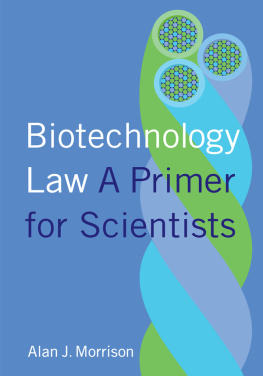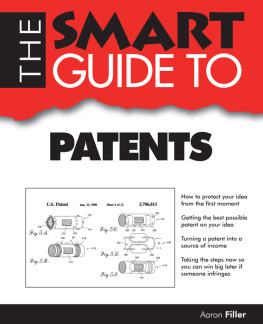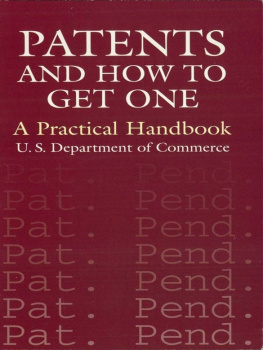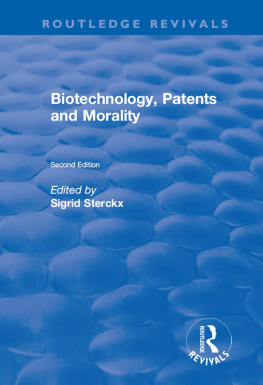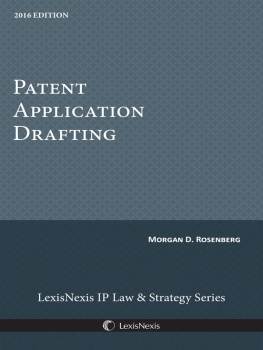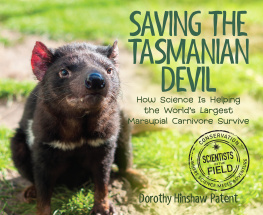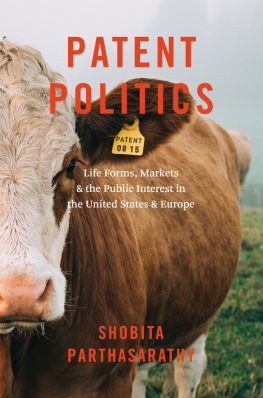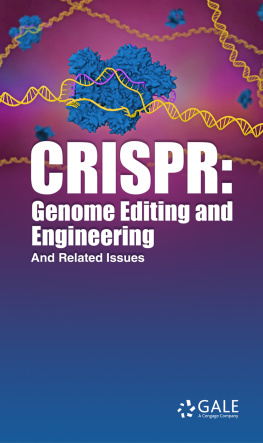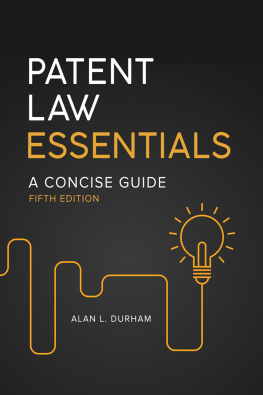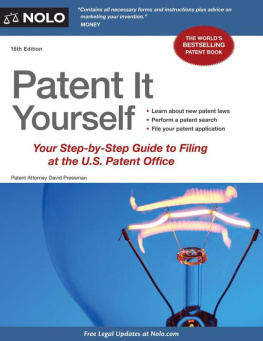Table of Contents
BIOTECHNOLOGY LAW
ALAN J. MORRISON
BIOTECHNOLOGY LAW
A Primer for Scientists
COLUMBIA UNIVERSITY PRESS
NEW YORK
Columbia University Press
Publishers Since 1893
New York Chichester, West Sussex
cup.columbia.edu
Copyright 2020 Alan J. Morrison
All rights reserved
E-ISBN 978-0-231-55092-5
Library of Congress Cataloging-in-Publication Data
Names: Morrison, Alan J., author.
Title: Biotechnology law: a primer for scientists / Alan J. Morrison.
Description: New York: Columbia University Press, 2019. | Includes bibliographical references and index.
Identifiers: LCCN 2019023643 (print) | LCCN 2019023644 (e-book) | ISBN 9780231179386 (cloth) | ISBN 9780231550925 (e-book)
Subjects: LCSH: Biotechnology industriesLaw and legislationUnited States. | BiotechnologyLaw and legislationUnited States. | Biotechnology industriesLaw and legislation. | BiotechnologyLaw and legislation.
Classification: LCC KF1893.B56 M67 2019 (print) | LCC KF1893.B56 (e-book) | DDC 343.7307/86606dc23
LC record available at https://lccn.loc.gov/2019023643
LC e-book record available at https://lccn.loc.gov/2019023644
A Columbia University Press E-book.
CUP would be pleased to hear about your reading experience with this e-book at .
Cover design: Melinda Beck
CONTENTS
I m an attorney. Six years ago, I joined the faculty of Columbia Universitys Department of Biological Sciences. I can explain.
At the time, teaching law to scientists was unorthodox. Doing so for an entire semester was even more so. Yet, the department wanted to take this step by offering a graduate biotech law course through its M.A. in Biotechnology program. They presented me with the honor of designing and teaching it. How could I say no? I had long known that law is indispensible to the biotech industry. I also believed that it should be part of every scientists education.
The contours of biotechnology law are not clear to most. So, to design the course, I first had to define that term. In a sense, defining biotechnology law is akin to taking a Rorschach test. Everyone does it differently, and how one does it reveals much about their own professional outlook.
My own outlook, of course, came from decades of representing biotech companies, universities, research institutes, and investors. My work for them centered on patents, transactions, and, tangentially at least, regulatory matters. It was through the prism of this experience that I defined biotechnology law to include patent, regulatory, and contract law. This was a sweeping definition. As such, it raised the question of exactly what I would cover within these three legal fields. I again turned to my own experience for the answer.
As a core part of my law practice, I had fielded countless questions from clients. Many were abstract. What makes an invention patentable? How is a patent a negative right? How does patent prosecution work, and how long does it take? When is a patent infringed, and what types of infringement exist? How can patent infringement be avoided? What is a patent opinion, and what are its risks and benefits? What are the requirements for getting a small-molecule drug approved? What about a biologic drug? How does regulatory exclusivity work, and how does it relate to patent protection? How does generic drug approval work, and what is ANDA litigation? What is a biosimilar, and what is the patent dance? What are the features of a confidentiality agreement? How does a patent license work? What is the difference between an exclusive and nonexclusive license? What does the grant clause do? What does a drug development agreement accomplish? What might its core provisions be? The list goes on.
The answer to each question was a concise explanation of just one or two points of law. Together, though, they made up the fundamentals of patent, regulatory, and contract lawor at least the fundamentals that I wished my clients had understood before discussing their cases with me. My course was to be for science students. What better template for its content, then, than the answers to questions my clients had actually asked over the years?
While designing the course, I also searched for an appropriate textbook. I found none and had to rely instead on detailed lecture notes, slides, and a semesters worth of class time. In the end, of course, my students learned the material.
Yet, what of the far larger group of those who need to learn this subject but havent the time, ability, or inclination to take a semester-long course? What of those who, like my clients, seek a better graspor simply a graspof biotechnology law so that they can derive more from their time with counsel? What of the start-up founder filing her first patent application, or the regulatory specialist foreign to patent law yet needing to comprehend ANDA litigation? What about the in-house patent liaison grappling with the field-of-use provision in a patent license, or the private equity investor unfamiliar with the basics of patent opinions?
Those in this groupstart-up founders, regulatory specialists, patent liaisons, investors, and other scientifically trained nonattorneysneed a biotechnology law book written just for them. They need a book that is at once practical, clear, concise, and suitable for independent use.
This book is my humble attempt to provide just that.
T he biotechnology industry is not a creature of science alone. Many forces beyond science helped make this industry what it is today. Money and a welcoming infrastructure are among the greatest. So is law.
Biotechnology could not have changed the world as it has without laws. Those laws help transform discoveries into products. They help ensure that those products are safe and effective. They also safeguard the rights and rewards of the companies, institutions, universities, and scientists moving the industry forward. Without these laws, biotechnologys commercial triumphsrecombinant antibodies, CRISPR-based gene editing, molecular diagnostics, adoptive cell therapy, transgenic animals and plants, microarrays, high-throughput screening, next-generation DNA sequencing, and morewould scarcely have transcended academia.
There is no singular edict titled biotechnology law. No individual statute or rule governs all aspects of this field. Nor does any one court decision. What is more, there is no universally accepted definition of biotechnology law. What, then, is meant by the first two words of this books title?
A broad definition of this term could reasonably include any law affecting the development, manufacture, use, or marketing of a biotech product or service. Corporate law, tax law, labor law, and product liability law, for instance, fall neatly into this category. That is, each of these sweeping practice areas affects the biotech industry in some way. Biotherapeutic companies all pay taxes. They must also contend with such matters as corporate structure and shareholder rights, employee hiring practices and health care rights, and possible harm to consumers caused by faulty products.
Yet, three fields of law shape the biotech industry perhaps more profoundly than any other. They are patent law, regulatory law, and contract law. Each field is deeply intertwined with the science it governs. This makes scientific knowledge useful, and often necessary, for understanding many of the concepts integral to it. Such is the case, for example, with understanding the scope of a patent claim to a recombinant antibody drug, the relative merits of pursuing regulatory approval for a biosimilar or biobetter drug, or the possible shortcomings of the grant clause in a patent license agreement relating to cell-based therapeutics.

